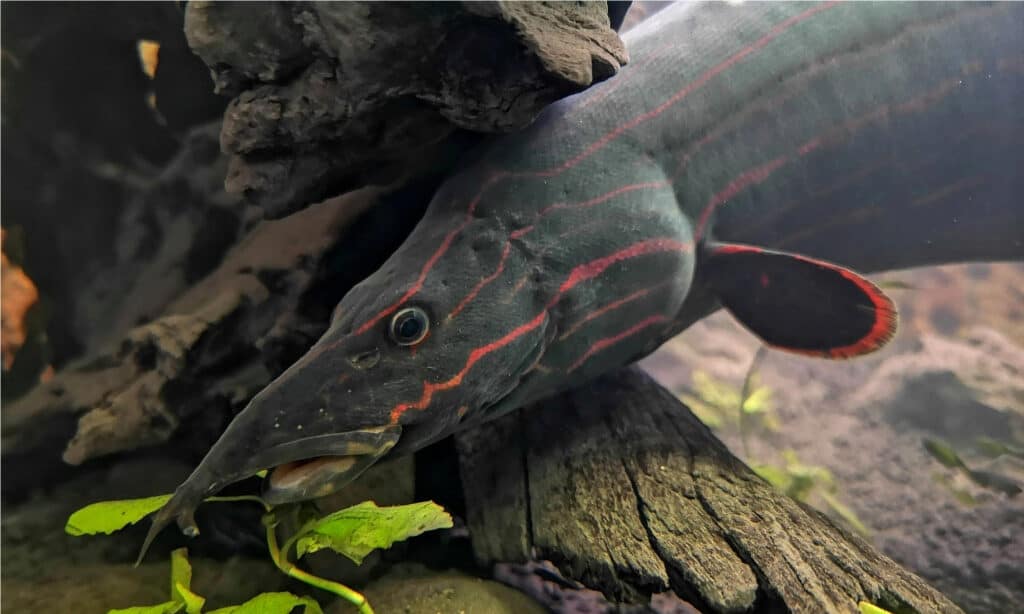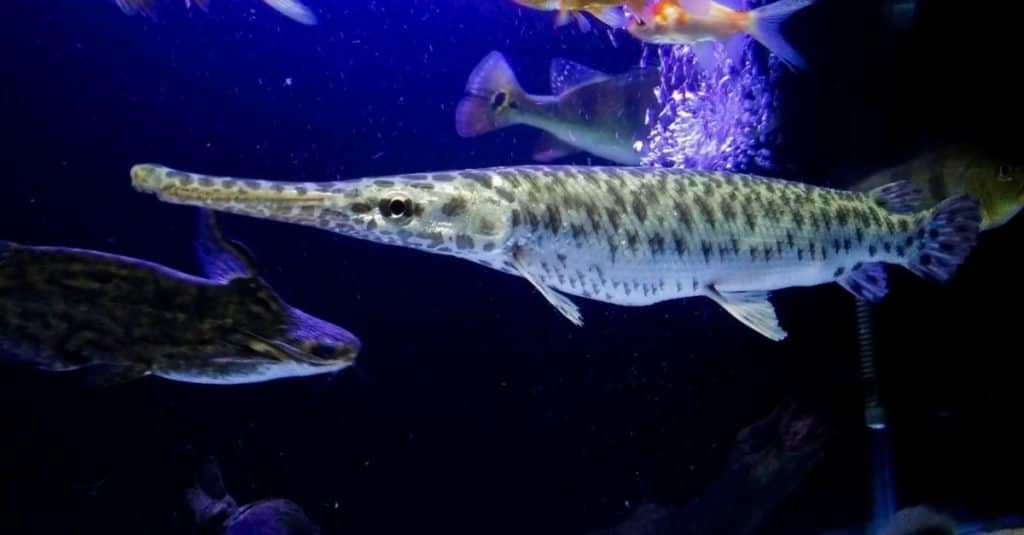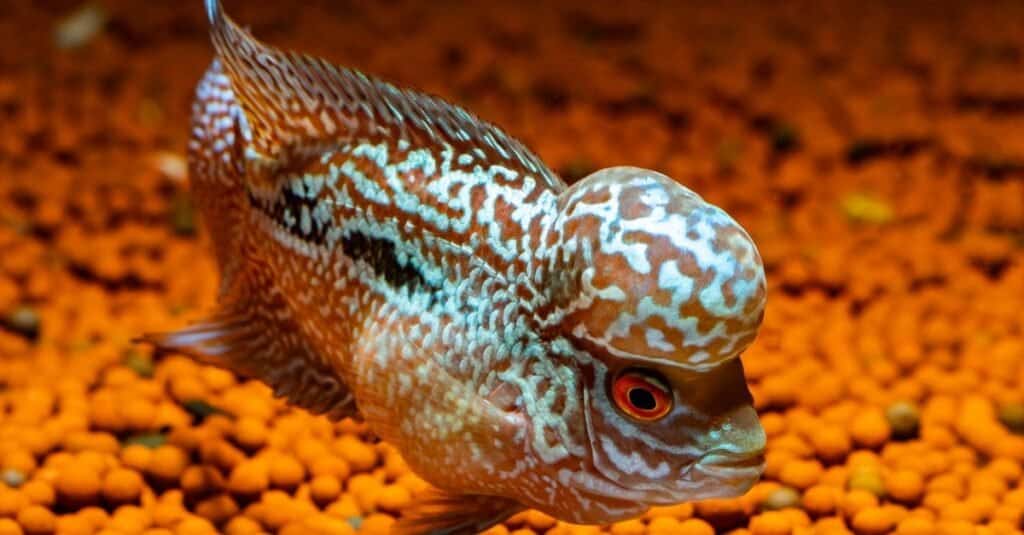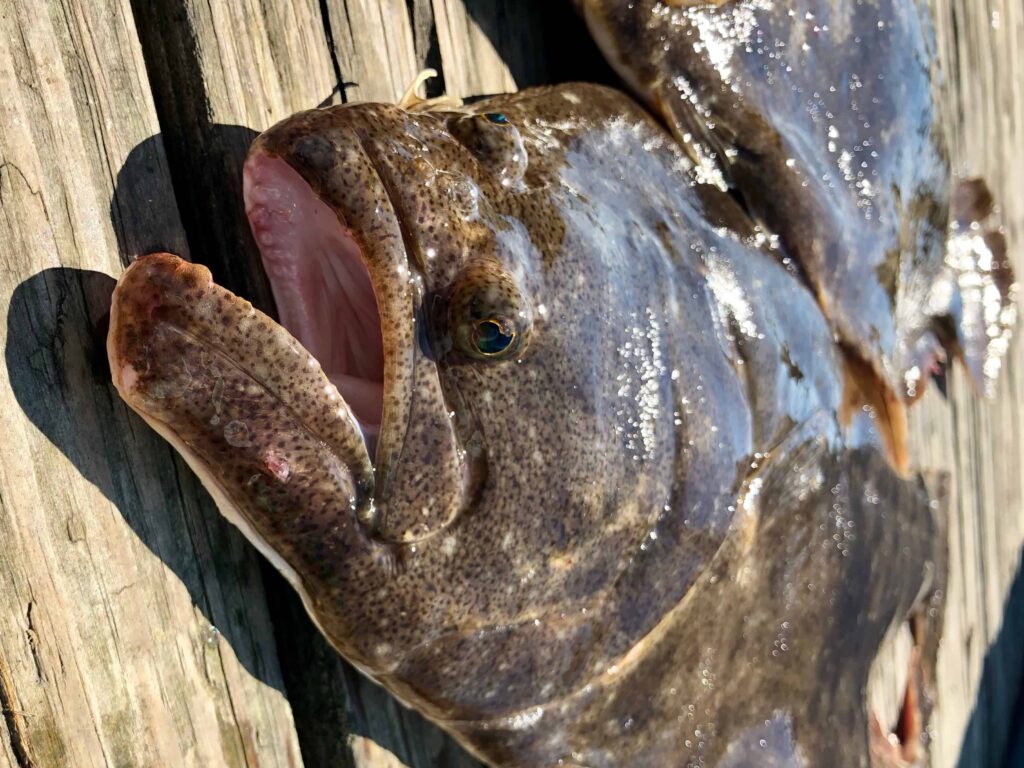We are making our way through the alphabet to discover the fish that start with each letter of the alphabet. We have finally reached the letter “F.” And we have formed an exclusive list of 85+ fish whose common names begin with “F.”
While 85 fish may sound like a lot, in comparison to how many fish there are in the world, it is not that many. While no one can give an exact number of fish in existence, the educated guess is that there are 3.5 trillion in total.
Let’s dive right into the ocean’s depths and start with one of the scariest-looking fish that starts with the letter “F.”
Fangtooth (Anoplogaster spp.)

The population size of the
fangtooth
fish is unknown.
©3DMI/Shutterstock.com
This nightmare of a looking fish brings us to the deep sea. The fangtooth (Anoplogaster spp.) resides in the deep where the ocean depths can go as far as 2.3 miles deep.
As we can see from the picture above, these fish teeth are something to be talked about. In comparison to their body size, their teeth are quite large. These teeth are estimated to be about 6 inches in length.
The fangtooth is a carnivore that preys on smaller fish and large squid. With their gigantic teeth, this helps them to easily tear the skin of fish and eat them with ease.
Fire Eel (Mastacembelus erythrotaenia)

The fire eel will live about 10-20 years.
©Cheng Wei/Shutterstock.com
The fire eel (Mastacembelus erythrotaenia) of the family Mastacembelidae resides in rivers and lakes. They can be found in various locations worldwide, such as Southeast Asia, Laos, Vietnam, Pakistan, and Malaysia, to name a few.
This eel reaches lengths of 20-40 inches long and heights of four inches. As omnivores, they feast on bloodworms, shrimp, invertebrates, and small fish.
What helps to set the fire eel apart from other eels is that they are very colorful. They will often have red stripes on their scales.
Flathead Catfish (Pylodictis olivaris)

The flathead
catfish
are nocturnal fish. Which means that they are active during the night.
©iStock.com/stammphoto
As you can imagine with the name flathead catfish, this catfish does indeed have a flat head.
Flathead catfish (Pylodictis olivaris) reside in Central and North America.
Their physical appearance is brown, yellow, and white color. Their underbellies are an off-white shade.
The flathead catfish is known for its predatory status in the waters, meaning it has a very high aggression level. Because of this, the flathead catfish do not have predators outside their species, and when humans catch them.
Florida Gar (Lepisosteus platyrhincus)

The Florida garfish produces toxic eggs that work as a repellent against predators.
©Oyek Photo/Shutterstock.com
Easily resembling an alligator, the Florida gar (Lepisosteus platyrhincus) can be found in North America.
This slender-looking fish can weigh as much as 10 pounds and reach up to 1.3 meters (52 inches long). Their scales are brown, black, white, and green in appearance.
Oddly enough, for looking like an alligator, this fish’s predators are indeed alligators, along with birds and humans.
As carnivores, the Florida gar is famous for preying on fish, shrimp, and crayfish. They live in a group called a school setting which makes it easy for them to prey on their food.
Flounder (Paralichthys)

This flat flounder fish can remain still for an extended period to trick potential prey.
©iStock.com/Getty Images
This flat-looking fish is called a flounder (Paralichthys) weighs as much as 22 pounds and can be anywhere from 8.7-23.6 inches long.
They reside in habitats close to docks, bridges, or reefs in the ocean. Due to the numerous flounders, their exact population is unknown. Because of this, their conservation status is not dangered, and their population is of the least concern.
This fish will feast on shrimp, crabs, and other types of fish. The predators who prey on flounders are sharks, eels, and even humans.
Flowerhorn Fish (Amphilophus hybrid)

The flowerhorn fish is a freshwater fish.
©nicefishes/Shutterstock.com
This next fish is an odd-looking fellow. He is shaped to fit the common name given to him as the flowerhorn fish (Amphilophus hybrid). And as we can see, and the name that gives it away, this fish has a horn shape on top of his head. Perhaps we could call him the unicorn of the sea?
The flowerhorn fish of the family Cichlidae weighs only one pound and reaches up to 16 inches long. They are colorful in their appearance and can be red, blue, black, white, green, or orange in appearance.
This fish preys on shrimp, worms, insects, and plant matter as an omnivore. The predators for this fish pretty much cover other larger fish in the area.
Fluke Fish, summer flounder, (Paralichthys dentatus)

The fluke fish can change colors to camouflage itself.
©Shutterstock Media/Shutterstock.com
The fluke fish, or another common name the summer flounder, (Paralichthys dentatus) of the family Paralichthyidae can be found from Florida to Nova Scotia even. During winter, the fluke fish will dive further into the deep sea.
These rather drab-looking fish are brown. Oddly enough, they can camouflage themselves well in the water because of their color. They can reach up to 20 pounds and grow to lengths of three feet.
These flounders will enjoy a wide variety of food, such as crabs, squid, shrimp, anchovies, and other flounders. Sharks, rays, and monkfish regularly hunt the fluke fish.
Football Fish (Himantolophidae)

Pacific Football Fish also known as Himantolophus sagamius. The football fish possesses a large, round, or oval-shaped body that resembles a football.
©Jules_88/Shutterstock.com
Perhaps we spoke a little too quickly when we said the fangtooth fish at the start of this article was the top nightmarish-looking fish with the letter “F.” The football fish (Himantolophidae) would probably tie places with the fangtooth in that department.
As its name suggests, this fish’s head is shaped oblong like a football. Not only are they shaped like it, but they are also brown and black in appearance as well.
These fish weigh approximately 24 pounds and have various sizes from 1-24 inches long. The football fish prey on fish, crustaceans, and squid. Regarding predators, other football fish, sharks, and whales will hunt and eat them.
Flying Fish (Exocoetidae)

Flying fish have wings that help them to glide across the water with ease.
©Agami Photo Agency/Shutterstock.com
In case you were wondering, yes, the flying fish (Exocoetidae) can fly. Well, more like gliding in the air for a while before it goes back down.
These beautiful-looking fish come in sun-glistening colors like blue, silver, white, and black. They weigh up to two pounds and can reach anywhere from 6-20 inches long.
These omnivores will enjoy feasting on small fish, crustaceans, and plankton. Those who would hunt and eat flying fish are a variety of animals such as marlins, tuna, squid, porpoises, birds, and, yes, even humans.
Freshwater Jellyfish (Craspedacusta sowerbyi)

Freshwater
jellyfish
live in a colony.
©Rostislav Stefanek/Shutterstock.com
This freshwater jellyfish (Craspedacusta sowerbyi) has the appearance of being very clear. Its colors, though, are truly white and sometimes green.
These small jellyfish weigh approximately 0.11-0.18 ounces and are 0.20-1 inch long. There is no fear of this fish going extinct as there is an estimated population that is well into the millions worldwide.
Due to their size, the jellyfish typically just eat zooplankton and copepods to sustain themselves. Because they can poison and paralyze their prey, fish tend to avoid these little guys.
The Largest Fish That Starts With the Letter “F”

Bull sharks are aggressive.
©Harry Collins Photography/Shutterstock.com
While there are many large fish in the ocean, the largest of all being the famous whale shark. However, we are turning our attention to which is the largest fish that starts with the letter “F.” As we scoured and researched, our findings ended on the freshwater bull shark (Carcharhinus leucas).
This shark, more commonly known as a bull shark, can survive in both fresh and saltwater. These sharks can grow to be eight feet long and weigh 290 pounds. Interestingly enough, females outweigh the males by about 80 pounds.
The bull shark will reside in rivers and lakes all over the world. They can be found in Massachusetts, Brazil, Morocco, and Angola, to name a few.
This solitary hunter will prey on bony fish, other sharks, and even their species of bull sharks.
Now that we have looked at these two amazing fish that start with the letter “F,” let’s take a deeper look into 85+ fish that start with the letter “F” with both their common and scientific names
Complete List of 85+ Fish That Start With the Letter “F”
| Common Name (Fish that start with “F”) | Scientific Name |
|---|---|
| False trevally | Lactarius lactarius |
| Filefish | Monacanthidae |
| Fire goby | Nemateleotris magnifica |
| False catshark | Pseudotriakis microdon |
| Fathead sculpin | Psychrolutidae |
| Featherback | Notopterus notopterus |
| False brotula | Parabrotulidae |
| Fangtooth | Anoplogaster |
| False moray | Kaupichthys hyoproroides |
| Fierasfer | Saurenchelys fierasfer |
| Frigate mackerel | Auxis thazard |
| Flathead | Pylodictis |
| Flabby whale fish | Cetomimidae |
| Freshwater shark | Carcharhinus leucas |
| Frogmouth catfish | Chaca |
| Freshwater hatchetfish | Gasteropelecidae |
| Frilled shark | Chlamydoselachus anguineus |
| Flashlight fish | Anomalopidae |
| Finback cat shark | Proscylliidae |
| Flying fish | Exocoetidae |
| Flying gurnard | Dactylopterus volitans |
| Flier | Centrarchus macropterus |
| Flounder | Paralichthys dentatus |
| Flagblenny | Emblemariopsis carib |
| Freshwater eel | Anguillidae |
| Fingerfish | Monodactylidae |
| Flagfin | Pterronotropis signipinnis |
| Flatfish | Pleuronectiformes |
| Forehead brooder | Kurtus |
| Flagfish | Jordanella floridae |
| Four-eyed fish | Anableps |
| Footballfish | Himantolophidae |
| Firefish | Pterois volitans |
| Flagtail | Kuhliidae |
| Fusilier fish | Caesionidae |
| Frogfish | Antennariidae |
| Flathead catfish | Pylodictis olivaris |
| French angelfish | Pomacanthus paru |
| Fire bar danio | Devario maetaengensis |
| False cat shark | Pseudotriakis microdon |
| Fire Eel | Mastacembelus erythrotaenia |
| Florida Gar | Lepisosteus platyrhincus |
| Flounder | Paralichthys |
| Flounder Fish | Paralichthys dentatus |
| Flowerhorn Fish | Amphilophus hybrid |
| Fluke Fish (summer flounder) | Paralichthys dentatus |
| Football Fish | Himantolophidae |
| Freshwater Drum | Aplodinotus grunniens |
| Freshwater Jellyfish | Craspedacusta sowerbyi |
| Freshwater Sunfish | Centrarchidae |
| Firemouth cichlid | Thorichthys meeki |
| Fairy cichlid | Neolamprologus brichardi |
| False Bumblebee Catfish | Pseudomystus stenomus |
| Fathead Bichir | Polypteridae |
| Feather-Barbel Catfish | Opsodoras stuebelii |
| Featherfin | Synodontis eupterus |
| Featherfin Synodontis | Synodontis eupterus |
| Festivum | Mesonauta festivus |
| Fighting Loach | Nemacheilus selangoricus |
| Figure Eight Pufferfish | Tetraodon biocellatus |
| Filament Tetra | Bryconaethiops microstoma |
| Fire Stingray | Potamotrygon henlei |
| Fire Tail | Epalzeorhynchus bicolor |
| Fire-Tailed Gudgeon | Hypseleotris galii |
| Five-Banded Barb | Barbus pentazona |
| Five-Bar Cichlid | Neolamprologus tretocephalus |
| Five-Spot African Cichlid | Thysochromis ansorgii |
| Flag Cichlid | Laetacara curviceps |
| Flag-Tailed Catfish | Dianema urostriata |
| Flag-Tailed Corydoras | Corydoras robineae |
| Flame Tetra | Hyphessobrycon flammeus |
| Flat-Whiskered Catfish | Pinirampus pirinampu |
| Fly River Rainbowfish | Melanotaenia sexlineata |
| Flying Fox | Epalzeorhynchus kallopterus |
| Fly-Speckled Hardyhead | Craterocephalus stercusmuscarum |
| Fork Tailed Lamprologus | Neolamprologus furcifer |
| Four-Barred Tigerfish | Datnioides quadrifasciatus |
| Four-Spine Cichlid | Neolamprologus tetracanthus |
| Four-Stripe Julie | Julidochromis regani |
| Freiberg’s Peacock | Aulonocara jacobfreibergi |
| Freiberg’s Peacock Cichlid | Aulonocara jacobfreibergi |
| Freidrichsthal’s Cichlid | “Cichlasoma” freidrichsthalii |
| Freshwater Barracuda | Ctenolucius hujeta |
| Freshwater Bat Fish | Myxocyprinus asiaticus |
| Freshwater Moray Eel | Echidna rhodochilus |
| Freshwater Ray | Potamotrygon hystrix |
| Frontosa Cichlid | Cyphotilapia frontosa |
The photo featured at the top of this post is © luis2499/Shutterstock.com
Thank you for reading! Have some feedback for us? Contact the AZ Animals editorial team.






